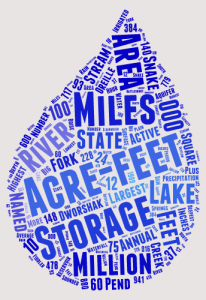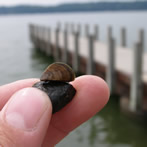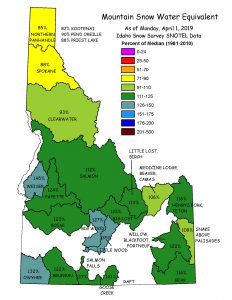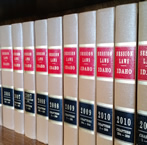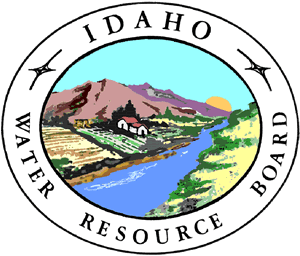IDWR Rulemaking
The Idaho Administrative Procedure Act (“APA”) (Title 67, Chapter 52, Idaho Code), which governs rulemaking in Idaho, defines rulemaking as the process for the formulation, adoption, amendment, or repeal of a rule. This process can be driven by a number of different events but two of the most common are the enactment of a new or amended statute by our state Legislature or the enactment of a new law or regulation by the federal government. However, a citizen’s petition to amend or adopt a new rule, a change in an agency’s process or procedure requirements, a court order, or the need to simply update the rule can cause an agency to initiate rulemaking and set the process in motion.
In Idaho, rules are typically proposed by state agencies, opened for public comment, and in many instances, reviewed by a board of citizens appointed by the governor. If approved by the board, the rules are then sent to the Legislature for review. If the Legislature does not act on the rules, they automatically take effect at the end of the legislative session. However, legislative action affirmatively approving a rule is required when a rule implements a new fee or revises an existing fee. Rules are compiled in administrative codes and people who do not adhere to the rules may be subject to enforcement actions. Rules specifically governing the actions of the Idaho Water Resource Board (IWRB) and the Idaho Department of Water Resources (IDWR) are contained in Chapter 37 of the Idaho Administrative Code.
When feasible, negotiated rulemaking is conducted with interested parties, in order to improve the final rule and expedite the rulemaking process by drawing upon shared information, knowledge, expertise, and technical abilities. Negotiated rulemaking begins with the publication of a Notice of Negotiated Rulemaking in the Idaho Administrative Bulletin. In the event the IWRB or IDWR determines that negotiated rulemaking is not feasible, they will publish an explanation of the basis of the determination in the Notice of Rulemaking – Proposed Rule. Following negotiation, the IWRB or IDWR will publish a Notice of Proposed Rule and the text of the proposed rule. Both documents are published in the Administrative Bulletin, as well as on IDWR’s website.
The Idaho APA requires public comment as part of the rulemaking process. (Expand the Submit a Public Comment tab, below for submission information). After a proposed rule’s comment period has passed, and after any requested hearings have been held, the IWRB or IDWR will publish a Notice of Pending Rule. Pursuant to the Idaho APA, all pending rules are sent to the Legislature for review. Pending rules will become effective when the Legislature adjourns sine die, unless both chambers of the Legislature vote to disapprove a particular pending rule. Rules are compiled in the Idaho Administrative Code and have the force and effect of law.
The IWRB’s and IDWR’s Current rules are published on the Office of Administrative Rules website here:
IDAPA Chapter 37: Idaho Water Resource Board and Idaho Dept. of Water Resources
Additionally, click the links below to view each Rule chapter.
37.01.01 – Rules of Procedure of the Idaho Department of Water Resources
37.02.01 – Comprehensive State Water Plan Rules
37.02.03 – Water Supply Bank Rules
37.02.04 – Shoshone – Bannock Tribal Water Supply Bank Rules
37.03.02 – Beneficial Use Examination Rules
37.03.03 – Rules and Minimum Standards for the Construction and Use of Injection Wells
37.03.04 – Drilling for Geothermal Resources Rules
37.03.05 – Mine Tailings Impoundment Structures Rules
37.03.06 – Safety of Dams Rules
37.03.07 – Stream Channel Alteration Rules
37.03.08 – Water Appropriation Rules
37.03.09 – Well Construction Standards Rules
37.03.10 – Well Driller Licensing Rules
37.03.11 – Rules for Conjunctive Management of Surface and Ground Water Resources
37.03.12 – Idaho Department of Water Resources Water Distribution Rules – Water District 34
The Idaho APA requires public comment as part of the rulemaking process. If you are interested in providing comments on one or more of the proposed rules, you may do so by submitting your comments in writing to the person named in the Notice, or by submitting comments to: rulesinfo@idwr.idaho.gov. Please specify the rule name in your comments. Be aware that public comments are part of the rulemaking record and are public record.
Click the links below to view current and recent rulemaking dockets:
The IWRB’s and IDWR’s archived rulemaking dockets can be accessed here:
If you have questions about IDWR’s rulemaking process contact rulesinfo@idwr.idaho.gov or contact Erik Boe, IDWR’s Rules Review Officer, at 208.287.4800.
Idaho Constitution & Statutes
Listed below are legal considerations regarding water rights, irrigation, and floodplain management in Idaho.
Idaho Constitution
Idaho Statute
- Title 42: Irrigation and Drainage — Water Rights and Reclamation
- Title 43: Irrigation Districts
- Title 46, Chapter 10: State Disaster Preparedness Act


